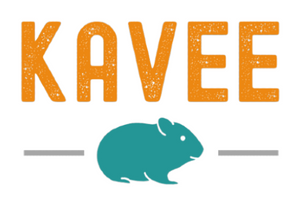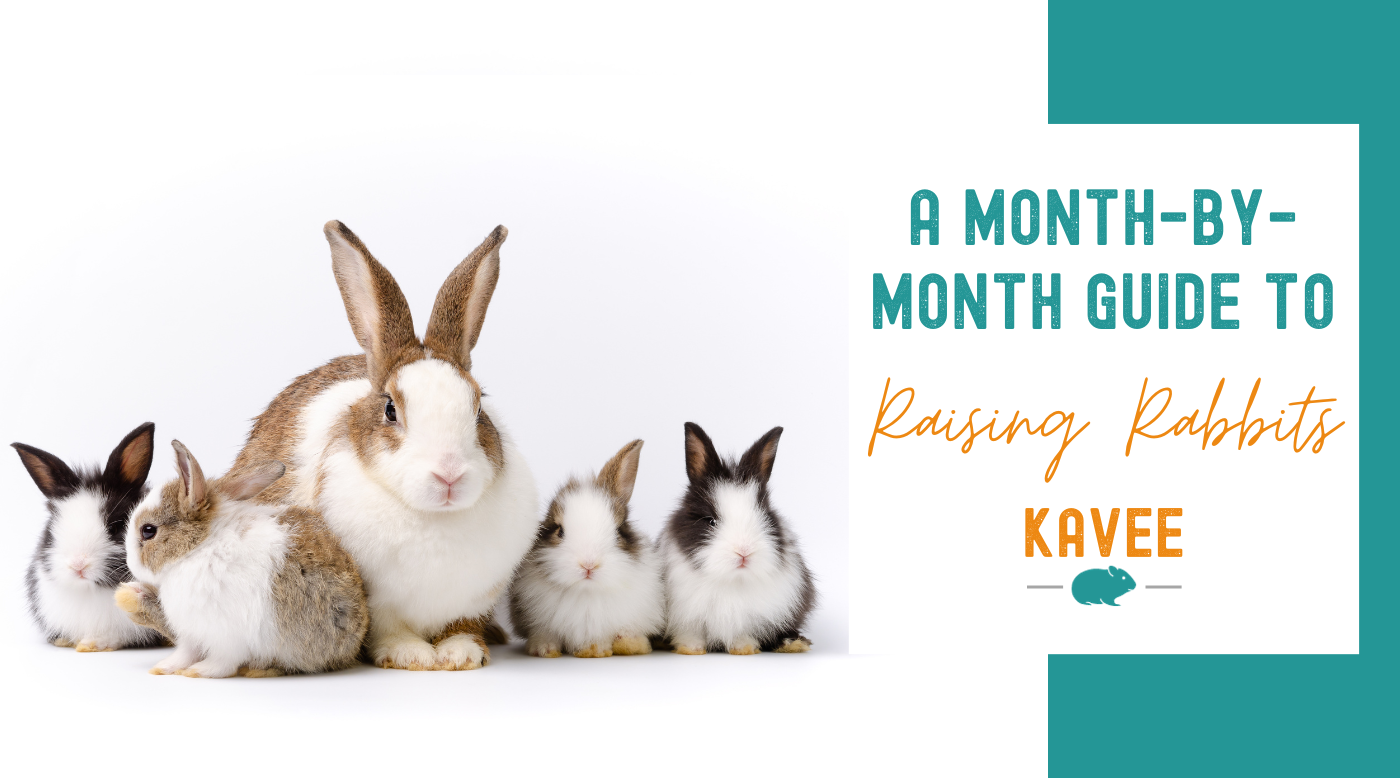Whether your pet rabbit is pregnant and you’re preparing for the pitter-patter of tiny paws, or you’re soon to be adopting some sweet buns, you’ve undoubtedly got many unanswered questions when it comes to raising rabbits!
To be a responsible bunny parent, it’s important to know what to expect at the different stages of their development. This way, you can properly support your sweet floofs at every growth stage and get happy binkying bunnies every year of their life.
So for all the first-time rabbit parents, here is your complete month-by-month rabbit care guide for perfectly healthy bunnies.

The First Six Months
We’ll go quite in-depth on a bunny’s first six months, but that’s because they have a lot of developing to do so there’s plenty to talk about! A baby rabbit is also known as a 'kit' or 'kitten', and requires specific care needs to blossom into a healthy adult.
Newborn Bunnies: 0-2 Weeks Old
A typical rabbit litter will consist of around 6 kits but could be anywhere up to 14. Baby rabbits arrive into the world small and helpless - blind, deaf, and without fur.
At this time, the tiny floofs rely solely on their mother’s milk, which is rich in fat and protein, and helps develop their immune system and protect them from diseases.
As cute as baby bunnies can be, it’s really important to allow their mom (or ‘doe’) to care for her newborns. But you can still do your part to support them:
- Provide them with a quiet and secure environment to minimize stress.
- Give them plenty of fresh water, and a nutritious diet for the mom.
- Stick to your regular cleaning schedule to keep their living area clean.
- Check the babies for full, round bellies to make sure they’re well-fed.
- Check that the mom is fulfilling her motherly duties with lots of TLC for her kits.
The Fuzz Stage: 2-4 Weeks Old
The ‘fuzz’ stage is when baby rabbits start to grow a fine layer of fur! Around 10-12 days old, their eyes and ears will open, allowing them to explore more of their surroundings. They will also begin to gain weight and grow in strength.
This is how you can best support your bunny mom and her kits at this stage:
- While their mother’s milk continues to be their primary source of food, you can introduce small amounts of alfalfa hay and rabbit pellets at 3-4 weeks old. This is a great way to provide them with plenty of fiber, one of the most important nutrients for rabbit digestion.
- Make sure that the mom is eating a well-balanced diet so that she produces enough milk.
- Keep the nest clean and monitor the babies for any signs of illness.
- If you are concerned that the doe is neglecting her babies (a rare occurrence that usually involves stress or malnutrition), then consult a bunny-savvy vet for advice on hand-rearing.

Exploration & Independence: 4-8 Weeks Old
During this phase, baby rabbits will gain more independence from their mother. Try the following to offer further support:
- While they’ll keep nursing on their mom’s milk, it’s time to introduce more hay and pellets. By week 7-8, the amount can be increased until they have access to an unlimited supply.
- Continue monitoring the weight and wellbeing of the kits - at this time, they should start producing their own cecotropes.
- Provide a clean and safe area for the baby buns to start exploring and gaining independence.
- At 4-5 weeks old, you can start to gently handle them to get them used to hooman interaction. This will especially be beneficial for when you try to groom them in the future!

Teenage Rabbits: 2-6 Months Old
This is the rabbit growth stage at which you’ll likely be bringing home your new addition(s) to the family! 8 weeks is considered the right time for bunnies to be separated from their mother.
During this phase, most buns will also reach 'sexual maturity' and so it's important to keep male and female rabbits away from each other to avoid any accidental pregnancies.
Teenage Rabbit Behavior
During a rabbit’s teenage years, they’ll undergo significant changes in behavior and their hormones will be a bit all over the place (not too dissimilar from us hoomans!). They may be territorial or aggressive, with increased urine marking and humping.
On top of what we discussed in the previous stage, you should add the following to your bunny parenting to-do list:
- Start litter training your buns (this can be done earlier but is generally more effective when they’re around 4 months old!).
- Give them bunny-safe chew toys to satisfy their need to nibble. Wooden ones are especially safer to give when your buns are at least 4 months old!
- Keep socializing with your buns to strengthen the bond.

Teenage Rabbit Health Concerns
A rabbit reaches sexual maturity around the 4-6 month mark, usually with males getting there earlier than females. Spaying or neutering bunnies is crucial not only to settle their hormonal behavior, but also to prevent pregnancy and reduce the risk of reproductive diseases and cancers.
So discuss this with your vet to find out more about what to expect and the procedure. Once spayed/neutered, you should notice a marked improvement in your rabbit’s behavior over the next month or so.
Teenage Rabbit Diet
Finally, a teenage bunny will transition to solids. Up to the 6-month mark, make sure to provide:
- Unlimited alfalfa hay - to aid digestion and provide essential nutrients.
- Good amount of high-quality alfalfa pellets - for calcium and protein. The exact amount will vary depending on whether the pellets will sway your bun from eating hay (which should be their main food!).
- Fresh leafy greens - Introduce them at around 3 months old, offering a variety of different options like arugula, parsley, and rocket. Just be careful to introduce new foods slowly and one at a time so that it doesn’t play havoc with their digestive system!

Six Months to a One Year Old
Between the 6-month and 1-year mark, rabbits make the transition from adolescence into adulthood. Most small breeds will reach their full size and weight by their first birthday, although bear in mind that it may take up to 18 months for larger breeds.
Young Rabbit Behavior
Young rabbits are full of energy and will need plenty of space to exercise! They’re also tenacious diggers and chewers so they can be real troublemakers when left to their own devices. If they free-roam (our personal choice), then scour your home with a fine tooth comb to bunny-proof their space.
You’ll want to make sure stray wires and toxic houseplants are kept well out of reach to prevent any accidents, plus provide plenty of safe chew toys to satisfy their natural nibbling instincts.

Young Rabbit Health Concerns
Keep an eye on your bunny’s general health, such as any noticeable changes in eating, pooping, or energy. Misaligned teeth are a common problem at this age that can make eating incredibly painful if not addressed.
Discuss parasite control with your vet, including regular checks for external and internal critters (such as fleas and worms). If your bunny hasn’t been spayed or neutered yet, then it’s also time to get them fixed ASAP!
Young Rabbit Dietary Requirements
As they are still growing, you’ll want to continue to feed young bunnies more pellets than adults. However, you can start to gradually transition them from alfalfa to timothy hay and steadily increase the amount of leafy greens, decreasing to adult levels at the one-year mark.
Moving Into Adulthood: Year 1 Onwards
Adult Rabbit Behavior
As bunnies move into adulthood, their energy levels will begin to settle down and their unique personalities should start to shine through!
That said, adult rabbits are still active and require plenty of exercise, so you’ll want to give them at least 4-5 hours (but ideally as long as you can!) in a larger playpen or free-roam area to hop and play.
Chewing and digging will likely be less persistent, but don’t rest on your laurels! Adult rabbits still have these instincts, so chew toys, tunnels, and digging boxes will always be your best friend throughout their lifetime.
If you’re been diligent with their socialization from a young age, your buns should have developed a great bond with you and feel more comfortable in your presence. Plus, if you haven’t already, then do consider providing a pal for your bunny so they have a friend to play with and don’t get lonely.

Adult Rabbit Health Concerns
A yearly check-up at your local vet should be plenty for healthy adult rabbits, but do watch out for tell-tale signs that could indicate health problems:
- Behavior changes - watch out for drastic changes in your rabbit’s routine or personality that could indicate bigger problems.
- Digestive health - ensure your rabbit is regularly grazing on hay and pooping - if they haven’t pooped in 12 hours or more, consider it a medical emergency.
- Temperature and humidity - rabbits can suffer from heatstroke in summer and hypothermia in winter, so control their environment to ensure they’re kept away from direct sunlight, radiators, and draughts.
- Parasite prevention - housing your buns indoors will help to reduce the risk of nasty critters, but make sure to keep a clean and tidy cage too.
- Respiratory issues - cold-like symptoms such as wheezing or a runny nose should be addressed promptly.
Adult Rabbit Dietary Requirements
We’ve been through it in more detail in our rabbit nutrition guide, but for a quick recap of the basics, a healthy adult diet should stick to the following guidelines per day:
- An unlimited bundle of timothy hay, but at least the size of your bunny.
- 1-2 handfuls of nutritious leafy greens.
- A tablespoon of high-quality pellets.
- A spoonful or two of fruit or veggies (moderate the portions to avoid digestive issues and longer-term problems like obesity).
- A constant supply of fresh, clean drinking water.

How Kavee Products Support Your Rabbit's Growth
Here at Kavee, we’re proud to say that our products have been developed to provide the best support possible for your growing bunnies. Rabbits need more space than most people first assume, and sadly much more than the cages provided by most pet stores.
C&C cages give tons of room for rabbits to grow, and the side door lets them explore any bunny-proofed play area or room to their heart's content. Ease of access also has the added bonus of making daily and weekly cleans a breeze!
Just make sure you provide them with all the must-haves to keep them hoppy and healthy, and plenty of opportunities to play and hop about.

Conclusion
From helpless little kits to mischievous teenage bunnies, the needs of young rabbits will change from month to month in terms of diet, health care, and socialization. It’s a lot to juggle, but now that you’ve read everything related to raising rabbits, hopefully you feel more confident with the task at hand!
Remember that choosing a bunny as a pet is a real commitment in terms of time, attention, and care, especially for first-time rabbit owners. However, if you’re dedicated and consistent, it can be a truly wonderful and rewarding experience.
For products that have been designed to adapt to your rabbit’s needs at every stage of life, explore our range of indoor rabbit cages and fleece liners - the perfect way to set your bundles of fluff up for success!





